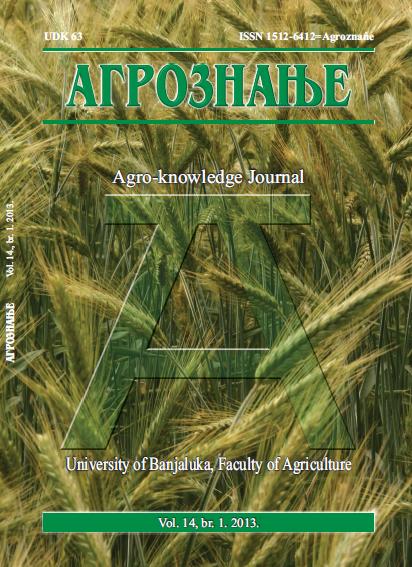The Content of Non-essential Amino Acids in the Grains of Winter and Spring Varieties of Oats (Avena sativa L.) under the Conditions of Central Southern Bulgaria
DOI:
https://doi.org/10.7251/AGREN1301105GAbstract
The purpose of this survey is to study the content of non-essential amino acids in four winter (Dunav 1, Ruse 8, Resor 1, Line M-K) and five spring (Obraztsov chiflik 4, Mina, HiFi, Novosadski golozarnest and Prista 2) cultivars of oats grown in Central Southern Bulgaria within the period from 2007 to 2009. The tested cultivars have different contents of non-essential amino acids. Dunav 1 has the highest quantity of glicine (5.12 g/100 g protein) of all the winter cultivars, Ruse 8 has the highest quantity of alanine (5.69 g/100 g protein) and Resor 1 – the highest quantity of arginine (6.14 g/100 g protein). Generally speaking, the spring cultivars have a larger quantity of glutamic acid (from 25.86 to 26.07 g/100 g protein) and proline (from 6.15 to 8.21 g/100 g protein) but a smaller quantity of glycine (from 4.68 to 4.99 g/100 g protein) compared to the winter cultivars. The naked cultivar Mina has the highest quantity of cystine (2.14 g/100 g protein), cultivar Prista 2 has the highest quantity of proline (8.21 g/100 g protein) and glutamic acid (26.07 g/100g protein) and HiFi ranks first in terms of aspartic acid (9.05 g/100 g protein), serine (5.02 g/100 g protein) and tyrosine (2.09 g/100 g protein). In the study we have also established certain relations between non-essential amino acids.Downloads
Published
2013-11-15
Issue
Section
Articles

